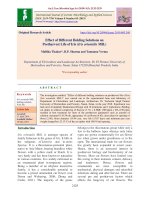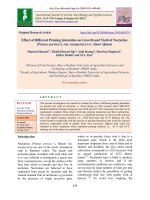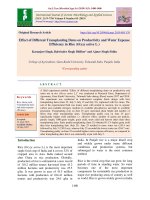Effect of co-inoculation of different bacterial cultures with rhizobium phaseoli on soil biological properties
Bạn đang xem bản rút gọn của tài liệu. Xem và tải ngay bản đầy đủ của tài liệu tại đây (125.49 KB, 6 trang )
Int.J.Curr.Microbiol.App.Sci (2019) 8(10): 604-609
International Journal of Current Microbiology and Applied Sciences
ISSN: 2319-7706 Volume 8 Number 10 (2019)
Journal homepage:
Original Research Article
/>
Effect of Co-inoculation of different Bacterial Cultures with
Rhizobium phaseoli on Soil Biological Properties
K. M. Nelwade*, Syed Ismail and R. A. Jadhav
Department of Soil Science and Agricultural Chemistry,
Vasantrao Naik Marathwada Krishi Vidyapeeth, Parbhani, Maharashtra 431402, India
*Corresponding author
ABSTRACT
Keywords
Co-inoculation,
Biological
Properties, Soil
Health,
Biofertilizers,
Microbial count,
Enzymatic activity
Article Info
Accepted:
07 September 2019
Available Online:
10 October 2019
The present experiment was conducted to study the changes occurred in biological
property under the influence of co-inoculation of different bacterial cultures with
Rhizobium phaseoli in blackgram grown Vertisols at Research farm, Department
of Soil Science and Agricultural Chemistry, Vasantrao Naik Marathwada Krishi
Vidyapeeth, Parbhani. The pre-evaluated bacterial cultures i.e. Rhizobium phaseoli
and seven other (Bacillus megaterium, Bacillus subtilis, Bacillus polymyxa,
Pseudomonas striata, Pseudomonas flurescens, Azotobacter chroococcum and
Azospirilllum lipoferum) in laboratory were used with RDF in randomized block
design. Seed treatment of black gram was done with 50 ml of Rhizobium phaseoli
and 50 ml of other bacterial cultures along with application RDF at the time of
sowing. Results emerged out indicated that the soil microbial population i.e. fungi,
bacteria and actinomycetes and enzymatic activity i.e. dehydrogenase, acid
phosphotase and alkaline phosphatase were highly influenced by co-inoculation
over mono-inoculation and control one. The treatments received co-inoculation of
Rhizobium phaseoli with Bacillus megaterium (T4), Pseudomonas striata (T7) and
Pseudomonas flurescense (T8) found strongly at par with each other and having
more potential than the other combinations.
Introduction
Indiscriminate use of synthetic chemical
fertilizers has led to the pollution and
contamination of the soil, has polluted water
basins, destroyed micro-organisms and
friendly insects, making the crop more prone
to diseases and reduced soil fertility (Syed
Ismail 2015). At this alarming stage to sustain
crop production and maintain soil fertility
integrated nutrient management is prime and
only option. The biofertilizers are one of the
major components of integrated nutrient
management having potential to work
efficiently to reduce such hazards. Microbial
inoculants are cost effective, eco-friendly and
renewable sources of plant nutrients. Plant
beneficial living microbial cultures (bio-
604
Int.J.Curr.Microbiol.App.Sci (2019) 8(10): 604-609
fertilizers) are supposed to be a safe
supplement to chemical fertilizers in order to
minimize the ecological disturbance.
Results and Discussion
The biochemical properties of soil have often
been proposed as early and sensitive indicators
of soil ecosystem health. Soil enzymes play an
essential role in energy transfer environmental
quality, organic matter decomposition,
nutrient cycling and crop productivity (Mina
et al., 2011). A number of microorganisms are
considered important for agriculture to
promote better enzyme activity and biological
health of soil.
The data noted in Table 1 indicates the
enzymatic activity of soil significantly
influenced by co-inoculation of bacterial
cultures with Rhizobium phaseoli.
Materials and Methods
Composite soil samples of 0-15 cm depth
were collected from individual plots after
harvesting the crop and stored a t low
temperature in deep freeze for determination
of microbial population and enzymatic activity
in soil after harvesting.
For the growth of bacteria, fungi and
actinomycetes three different media i.e.
Nutrient Agar, Rose Bengal and Ken knight
medium respectively were used.
The serial dilution technique described by
Dhingra and Sinclair (1993) was used for
particular group of microbes. Enzymes i.e.
dehydrogenase, acid phosphatase and alkaline
phosphates which play important role in soil
microbial respiration and phosphorous
mobilization respectively were analyzed by
using standard procedures described by
Tabatabai and Bremner (1969).
The results obtained were statistically
analyzed and appropriately interpreted as per
the methods described by Panse and Sukhatme
(1985). Appropriate standard error (S.E.) and
critical differences (C.D.) at 5 per cent levels
were worked out for interpretation of result.
Effect on Enzymatic activity
Dehydrogenase activity
The activity of enzyme dehydrogenase (39.47
µg g-1 soil) was significantly higher in
treatment T7 (RDF + Rhizobium phaseoli +
Pseudomonas striata) over other treatments
and found at par with treatment T8 (37.83 µg
g-1
soil)
having
co-inoculation
of
Pseudomonas fluorescens with Rhizobium
phaseoli. The minimum dehydrogenase
activity (29.57 µg g-1 soil) observed in
treatment T1 (absolute control). The
dehydrogenase participates in electron
transport system of oxygen metabolism so it
reflects the extent of oxidative activity of soil
microorganisms and is good indicator of
microbial activity (Nannipieri et al., 2002) and
due to high substrate availability the
dehydrogenase activity is also high.
Acid and alkaline phosphatise
The acid and alkaline phosphatase activities in
soil recorded high in treatment T8 (51.63 and
67.72 µg g-1 soil, respectively) receiving coinoculation of Pseudomonas fluorescens with
Rhizobium phaseoli which significantly
differed from other treatments.
The second and third higher value of acid
(50.84 and 50.44 µg g-1 soil, respectively) and
alkaline phosphatase (66.07 and 65.76 µg g-1
soil, respectively) was recorded in treatment
T4 (RDF + Rhizobium phaseoli + Bacillus
megaterium) and T7 (RDF + Rhizobium
phaseoli + Pseudomonas striata) which found
at par with treatment T8. The minimum acid
605
Int.J.Curr.Microbiol.App.Sci (2019) 8(10): 604-609
(30.25 µg g-1soil) and alkaline phosphatase
(54.42 µg g-1soil) activities were recorded in
treatment T1 (absolute control). Soil
phosphatase play a major role in the
mineralization processes of organic P
substrates and their activity can be influenced
by soil microbial population (Sarapatka,
2003).
However, activities of these enzymes were not
persistent, and sometimes found contrasting.
The acid phosphatase activity was much lower
than alkaline phosphatase activity, irrespective
of the treatments, which may be due to the
alkaline reaction of soil (Dick, 1994).
Similarly, Kaleeswari (2007) reported that
activities of both acid and alkaline
phosphatases were significantly improved
over control levels in the rhizosphere up on
inoculation. This might be due to increased
microbial and root activities.
Further, Nihorimbere et al., (2011) reported
more microbial activities increased the
dehydrogenase activity in rhizosphere due to
more availability of food material for its
growth. Badawi et al., (2011) also studied and
results revealed that, there was maximum
value
of
nitrogenase
activity
in
Bradyrhizobium + Serratia marcescens among
different inoculation treatments.
Similarly, Badda et al., (2013) concluded that
triple inoculation of A. laevis + T. viridae + P.
Fluorescence showed maximum increment in
both acid and alkaline phosphatase activity.
Moreover, Bodkhe et al., (2014) concluded
that an application of 75 % RDF and dual
inoculation significantly increased soil
enzymes activity. Our findings were matched
with results of Sable and Ismail (2017) that
activity of alkaline phosphatase and acid
phosphatase was noted significantly highest in
treatment RDF + Rhizobium + Bacillus
megaterium. Similarly, Vidhyashree et al.,
(2017) reported that dehydrogenase and
alkaline phosphatase activity in co-inoculated
treatment (PSB + Aspergillus awamori)
showed significant increase.
Effect on Microbial population
The data depicted in Table 2 indicates that the
soil microbial population shows distinct
differences under the influence of coinoculation of bacterial cultures with
Rhizobium phaseoli.
Bacterial population
With respect to culturable microbial
communities of the black gram soil the
bacterial load was highest in the treatment T7
(39 CFU X 107) receiving co-inoculation of
Pseudomonas striata and Rhizobium phaseoli
which found at par with treatment T4 (35.33
CFU X 107) having co-inoculation of Bacillus
megaterium with Rhizobium phaseoli.
The lowest bacterial population recorded in
treatment T1 (20.67 CFU X 107) which is
absolute control.
Due to co-inoculation of different bacterial
cultures with Rhizobium phaseoli population
of native and applied bacteria were increased
by multiplication (Bodkhe et al., 2014).
Actinomycetes population
Among treatments the treatment T7 having coinoculation of Pseudomonas striata with
Rhizobium phaseoli found significantly
superior in case of actinomycetes population
(32.67 CFU X 105) over rest of treatments and
found at par with treatment T4 (32.33 CFU X
105) having co-inoculation of Bacillus
megaterium with Rhizobium phaseoli and
treatment T8 (30.67 CFU X 105) receiving coinoculation of Pseudomonas flurescens with
Rhizobium phaseoli.
606
Int.J.Curr.Microbiol.App.Sci (2019) 8(10): 604-609
Table.1 Effect of co-inoculation of different bacterial cultures with Rhizobium phaseoli on
enzymatic activities in soil after harvest of black gram
Sr.
No.
Treatments
Dehydrogenase
(µg g-1 soil)
Acid
phosphatase
(µg g-1 soil)
Alkaline
phosphatase
(µg g-1 soil)
T1
T2
T3
T4
T5
T6
T7
T8
T9
T10
Absolute control
Only RDF
RDF + Rhizobium phaseoli
T3 + Bacillus megaterium
T3 + Bacillus subtilis
T3 + Bacillus polymyxa
T3 + Pseudomonas striata
T3 + Pseudomonas flurescens
T3 + Azotobacter chroococcum
T3 + Azospirillum lipoferum
S.Em.±
C.D. at 5 %
Initial Soil Sample
29.57
30.83
34.07
37.43
34.73
32.17
39.47
37.83
36.30
31.43
0.59
1.76
28.60
30.25
39.03
43.56
50.84
47.02
40.24
50.44
51.63
44.26
47.25
0.69
2.05
29.96
54.42
55.64
60.22
66.07
62.04
57.09
65.76
67.72
59.99
59.76
1.50
4.46
52.20
Table.2 Effect of co-inoculation of different bacterial cultures with rhizobium on microbial
population in soil after harvest of black gram
Sr.
No.
T1
T2
T3
T4
T5
T6
T7
T8
T9
T10
Treatments
Absolute control
Only RDF
RDF + Rhizobium phaseoli
T3 + Bacillus megaterium
T3 + Bacillus subtilis
T3 + Bacillus polymyxa
T3 + Pseudomonas striata
T3 + Pseudomonas flurescens
T3 + Azotobacter chroococcum
T3 + Azospirillum lipoferum
S.Em.±
C.D. at 5 %
Initial Soil Sample
Bacteria
(CFUX107)
25.67
29.67
31.33
35.33
31.33
29.67
39.00
34.67
30.00
27.00
1.25
3.70
23.00
607
Actinomycetes
(CFUX105)
21.00
22.33
26.33
32.33
26.67
22.00
32.67
30.67
27.33
23.33
1.93
5.73
19.00
Fungi
(CFUX104)
2.17
2.33
3.33
4.33
3.67
3.00
5.00
4.67
3.67
4.00
0.30
0.87
2.00
Int.J.Curr.Microbiol.App.Sci (2019) 8(10): 604-609
Fungal population
In case of fungal population the treatment
receiving RDF + Rhizobium phaseoli +
Pseudomonas striata (T7) recorded highest
fungal load (5.00 CFU X 104) which
significantly differed from other treatments at
5 per cent significance level and treatment T4
(4.33 CFU X 104) and T8 (4.67 CFU X 104)
having co-inoculation of Rhizobium phaseoli
with Bacillus megaterium and Pseudomonas
flurescens respectively, found at par with
treatment T7. The lowest actinomycets (21.00
CFU X 105) and fungal (1.67 CFU X 104)
population were recorded in treatment T1
(absolute control).
Increase in microbial population may be due
to growth promoting substances secreted by
crop during growth period. Similar results
were obtained by Saini et al., (2015) showing
co-inoculation of endophytic bacteria with
Rhizobium noted maximum microbial
population.
In line with our work, Goutami et al., (2015)
found that the maximum bacterial and fungal
population was noticed in the FYM inoculated
with biofertilizers while the minimum
population was recorded in treatment no
biofertilizer and FYM. Similarly, Sable and
Ismail (2017) conducted results indicated that
highest values of actinomycetes and bacterial
population were noted in treatment RDF
+Rhizobium and Bacillus megaterium
whereas, fungal population was highest in the
RDF+ Rhizobium+ Trichoderma sp. treated
soil. Further, Trabelsi and Mhamdi (2013)
reported that soil or seed inoculation may lead
to changes in the structure and population of
indigenous microbial communities. The
variation in efficacy of different treatment
combinations indicates the specificity of the
inoculation response. These results provide a
basis for the selection of an appropriate
combination of specific Pseudomonas sp. and
Rhizobium sp. which could further be utilized
for verifying the symbiotic effectiveness and
competitive ability of bio-inoculants under
field conditions (Mishra et al., 2011).
Significantly highest values of acid
phosphatase and alkaline phosphatase were
noted in treatment of Pseudomonas flurescens
along with Rhizobium phaseoli and RDF after
harvest of black gram while, co-inoculation of
Pseudomonas striata with Rhizobium phaseoli
helped in enhancement of dehydrogenase
activity. The significant increase in bacteria,
actinomycetes and fungi in soil after harvest
of black gram were recorded with coinoculation of Pseudomonas flurescens along
with Rhizobium phaseoli and RDF.
References
Badawi, F.Sh.F., Biomy, A.M.M. and Desoky,
A.H. (2011) Peanut plant growth and
yield as influenced by co-inoculation
with Bradyrhizobium and some rhizomicroorganisms under sandy loam soil
conditions. Annals of Agricultural
Science 56, 17-25.
Badda, N., Yadav, K., Kadian, N. and Aggarwal,
A. (2013) Impact of Arbuscular
Mycorrhizal Fungi with Trichoderma
viride and Pseudomona fluorescenson
growth enhancement of genetically
modified Bt-cotton. Journal of Natural
Fibers 10, 309–325.
Bodkhe, A.A., Syed Ismail and Syed Javed Jani.
(2014) Effect of chemical fertilizers and
microbial inoculants on soybean
(Glycine max)- safflower (Carthamus
tinctorius) cropping pattern. Green
Farming 5(3), 341-345.
Darine Trabelsi and Ridha Mhamdi (2013)
Microbial inoculants and their impact on
soil microbial communities: a review.
BioMed
Research
International
/>Dhingra, O.P. and Sinclair, I.B. (1993) Basic
plant
pathology
methods.
CBS
publisher, New Delhi, pp: 179-180.
608
Int.J.Curr.Microbiol.App.Sci (2019) 8(10): 604-609
Dick, R.P. (1994) Soil enzyme activities as
indicators of soil quality. In De Wning
soil quality for Sustainable Environment
(J.W. Doran, D.C. Coleman, D.F.
Bezdicek and B.A. Stewart, Eds.), SSSA
Special Publication No. 35, ASA and
SSSA, Madison, WI, pp. 104-124.
Goutami, N., Rani, P.P., Pathy, R.L. and Babu,
P.R. (2015) Soil properties and
biological activity as influenced by
nutrient management in rice- fallow
sorghum.
International
Journal
Agricultural Research, Innovation and
Technology 5(1), 10-14.
Kaleeswari, R.K. (2007) Role of phosphatase
enzymes in phosphorous nutrition of
crops. Agricultural Reviews 28(2), 149153.
Mishra, P.K., Bisht, S.C., Ruwari, P., Joshi,
G.K., Singh, G. Bisht, J.K. and Bhatt,
J.C. (2011) Bioassociative effect of cold
tolerant
Pseudomonas
spp.
and
Rhizobium leguminosarum-PR1 on iron
acquisition, nutrient uptake and growth
of lentil (Lens culinaris). European
Journal of Soil Biology 47, 35-43.
Nannipieri, P., Kandeler, E. and Ruggiero, P.
(2002)
Enzyme
activities
and
microbiological
and
biochemical
processes in soil. In Enzymes in
Environment (R.G. Burns and R.P. Dick,
Eds.), Marcel Dekker, New York, pp. 133.
Nihorimbere, V., Ongena, M and Smargiaji, M.
(2011) Beneficial effect of rhizosphere
microbial community for plant growth
and
health.
Biotechnological,
Agronomical and Environmental Science
5 (2), 327-337.
Panse, V. G. and Sukhatme, P. V., (1967)
Statistical Methods for Agricultural
Workers, Indian Council of Agricultural
Research, New Delhi.
Sable P. and Ismail Syed (2017) Effect of
different microbial inoculants on yield,
microbial population and chemical
properties in soil of groundnut grown on
Vertisol. International Journal of
Microbiological Research 9(1), 831-833.
Saini, R., Kumar V., Dudeja S.S. and Pathak
D.V. (2015) Beneficial effects of
inoculation of endophytic bacterial
isolates from roots and nodules in
chickpea. International Journal Current
Microbiology and Applied Sciences
4(10), 207-221.
Sarapatka, B. (2003) Phosphatase activities
(ACP, ALP) in agroecosystem soils.
Dissertation, Swedish University of
Agricultural Sciences.
Syed Ismail (2015) Liquid biofertilizers for
sustainable crop production. Chapter in
Emerging
Innovative
Areas
in
Agricultural Research 1st Edition,
Director of Instruction, VNMKV,
Parbhani (MS).
Tabatabai, M.A. and Bremner, J.M. (1969) Use
of P-nitrophenyl phosphate for assay of
soil phosphatase activity. Soil Biology
and Biochemisry 1,301-307.
Vidhyashree, C.V., Naga, S.R., Yadav, B.L.,
Shivran, A.C. and Singh, S.P. (2017)
Influence
of
phosphorus
and
biofertilizers on soil fertility and enzyme
activity of soils grown under mungbean
(Vigna
radiata
L.
Wilczek).
International Journal of Current
Microbiology and Applied Science
6(12), 737-741.
How to cite this article:
Nelwade, K. M., Syed Ismail and Jadhav, R. A. 2019. Effect of Co-inoculation of different
Bacterial Cultures with Rhizobium phaseoli on Soil Biological Properties.
Int.J.Curr.Microbiol.App.Sci. 8(10): 604-609. doi: />
609






![Effect of different plant growth regulators on shooting of stem cuttings in dragon fruit [Hylocereus undatus (Haworth) Britton & Rose]](https://media.store123doc.com/images/document/2020_01/09/medium_isb1578564896.jpg)


